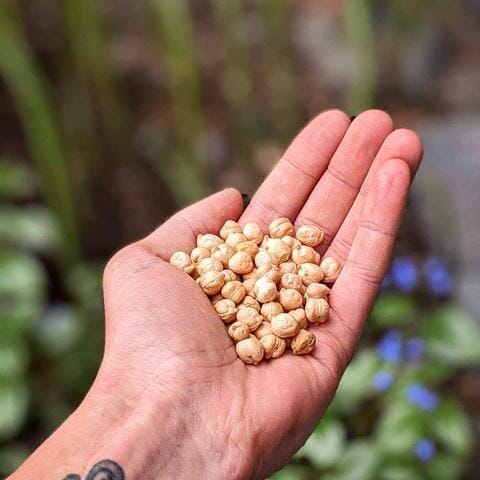What are pulses?
Pulses are the dried, edible seeds of plants in the legume family. You probably have some pulses in your kitchen right now. Think: beans, peas and lentils! They all grow in pods, even chickpeas! (Which sort of seems obvious when you think about it but I was still like ‘Woahh dooood” when I put that together.
Pulses have been cultivated by some of the earliest human civilizations, first evidenced in the Middle East almost 11,000 years ago.
In present day, hundreds of varieties of pulses are grown in 173 countries around the world!
Keep reading for highlights of my favourite pulses:

1. Chickpeas
Chickpeas (AKA garbanzo beans) are probably the pulse you have encountered the most in global cuisine. These light-coloured, spherical pulses are the foundation of many Middle-Eastern and Mediterranean staples such as hummus and falafel. Chickpeas can also be ground into flour which is used in the batter for the popular Indian fritters called pakoras.
There are 2 main types of chickpeas. Kabuli chickpeas are the larger, lighter, rounder kind that we are most familiar with in North America. Worldwide, the smaller, darker desi chickpea is more common. The darker colour of desi chickpeas means more antioxidants!
You likely have a can or two of chickpeas in your pantry right now. Canned chickpeas are already fully cooked and ready to go, making them a super convenient way to add easy, plant-based protein to salads and soups. If you’re a penny-pincher then dried chickpeas should be your go-to for the cheapest option, you just need to plan a head a little.
Nutritional Benefits of Chickpeas
Chickpeas are a great source of protein and fibre. 1 Cup of chickpeas contains almost half your daily intake of fibre! Chickpea fibre is primarily insoluble fibre. This type of fibre remains undigested until it reaches your colon where beneficial bacteria break it down into short chain fatty acids (SCFAs) which nourish the cells lining your digestive tract. Insoluble fibre also provides bulk, increasing the feeling of fullness, keeping things moving and promoting regularity.
The other ⅓ of the fibre in chickpeas is soluble fibre. This type of fibre forms a gel with water in our digestive system and can help lower blood cholesterol. The combination of protein and fibre in chickpeas also make them great regulators of blood sugar.
How to Cook Chickpeas
Dried chickpeas have a tough outer skin, which increases the cooking time. Soaking the beans in advance cuts the boiling time in half and also increases digestibility by removing some of the starches that can cause gas.
- Rinse dried chickpeas and cover with 3x as much water
- Soak the chickpeas at least 6 hours on the counter or up to 48 hours in the fridge
- Drain and rinse the soaked chickpeas
- Roll the soaked chickpeas in a towel to remove the skins (optional)
- Cover with water in a pot and bring to a boil
- Simmer for 60-90 minutes, until desired tenderness
- Drain and rinse the chickpeas

2. Black Beans
Black beans (AKA turtle beans, which is adorable) are small, oval-shaped beans with a black skin and white center. Native to the Americas, black beans have a creamy texture and slightly sweet flavour when cooked. They are popular around the world, but you have probably encountered them most in Latin and Asian cuisines.
Nutritional Benefits of Black Beans
Most of the calories in black beans come from carbs, most of these carbs being starches. What makes black beans unique is that a lot of these starches are “resistant starches” meaning they are not easily digested and pass though your upper intestines without being broken down. This low glycemic index is beneficial because it reduces the blood-sugar and insulin spikes associated with eating simple carbs. Furthermore, these starches provide food for beneficial bacteria in your colon that convert these resistant starches into short chain fatty acids (SCFAs) that fuel the cells lining your colon.
Have you heard about colourful foods being sources of antioxidants? Just like the colour black contains all other colours, the skin of black beans contains high levels of the colourful antioxidants we find in purple cabbage and blueberries!
Like other pulses, black beans are a fantastic source of protein and fibre.
How to Cook Black Beans
Black beans cook similar to chickpeas. They do not have as thick of an outer shell so you can skip the soaking step if you’re short on time.
- Rinse dried beans and cover with 3x as much water
- Soak the beans at least 6 hours on the counter or up to 48 hours in the fridge
- Drain and rinse the soaked beans
- Cover with water in a pot and bring to a boil
- Simmer for 45-70 minutes, until desired tenderness
- Drain and rinse the black beans

3. Dried Peas
Peas are distinguished from lentils and beans by their spherical shape. Dried peas are produced by drying the harvested peapods then removing the skins which causes the peas to naturally split. Preserving peas in this way provides the nutritional benefits of peas in a shelf-stable format that we can use year-round.
Nutritional Benefits of Dried Peas
Similar to other pulses, the fibre in dried peas helps lower cholesterol and manage blood sugar. The soluble fibre forms a gel in the digestive tract that binds cholesterol and carries it out of your body. This soluble fibre has also been shown to prevent constipation and irritable bowel syndrome. Regular consumption of peas can also reduce the risk of heart disease.
Dried peas are also a great source of plant-powered protein. The popular pea protein isolate comes from yellow peas! This highly digestible protein is made by separating the protein from the starch and fibre in dried pea flour. The proteins are first dissolved in an alkaline water solution. Acidifying this solution causes the proteins to solidify so they can be easily washed and purified without the use of chemical solvents.
Adding dried peas to soups and stews is a great way to thicken and add more protein and fibre!

4. Lentils
There are 2 types of lentils you are probably familiar with: large green lentils and red lentils. Both of these common types of lentils are grown primarily in Canada, India and Turkey. Red lentils are often split and peeled and sold as the brightly coloured split red lentils. You can recognize lentils by their round, flat, disk-like shape.
Nutritional Benefits of Lentils
When it comes to legumes, lentils have the fourth highest protein content! If you are looking for an easy and cheap plant-based protein source, lentils have you covered. Like other pulses, lentils are best paired with grains to complete the protein amino acid profile. Round off your lentil meal with whole grain bread or brown rice.
Lentils are also super sources of dietary fibre. A ½ cup serving of green lentils packs in more than a third of your daily recommended intake of fibre! Split lentils contain less fibre because the hull is removed, similar to brown rice vs white rice.
How to Cook Lentils
Since lentils lack the tough outer skin of many dried beans, you do not need to soak them before you cook them. Lentils can be cooked similarly to rice.
- Rinse and drain the lentils
- Cover 1 part lentils with 2 parts water
- Bring to a boil, then reduce heat and simmer for 20-40 minutes
The longer you cook lentils, the softer they will get. Cook your lentils longer and mushier if you plan to blend them in a recipe like lentil loaf. Cook them less for firm lentils that will hold their shape in salads or sides.
PRO(TEIN) TIP: Since lentils cook in almost the same time as rice, add lentils to your rice while cooking for an easy boost of protein and fibre! Pairing lentils (a pulse) with brown rice (a whole grain) will ensure you get all the essential amino acids for your protein needs!









